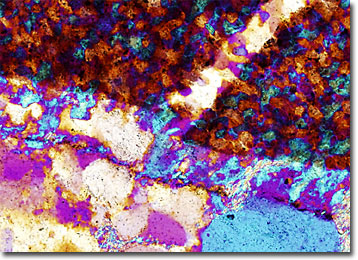Polarized Light Microscopy Digital Image Gallery
Quartzite Jasper Pebble
Quartz is one of the most common rock-forming minerals found on Earth and occurs in a variety of forms. A type of hard, metamorphic rock primarily comprised of interlocking quartz crystals is known as quartzite.

Jasper is a colored variety of chalcedony, a type of quartz with a cryptocrystalline structure that can only be seen with the help of a microscope. The beautiful mineral, which is opaque, may appear in a variety of hues including pink, yellow, green, blue, and gray, but is perhaps best known in a shade of reddish brown. Impurities in jasper may create a variety of banding patterns in the stone as well, some of which are said to resemble landscapes. The unusual appearance of jasper has fascinated humans for thousands of years, and references to the material can be found in the ancient literature of the Greeks, Romans, and Assyrians.
Though jasper naturally exhibits a dull luster, the silica-based mineral may be polished to a high sheen. It is, therefore, commonly utilized as a gemstone and for ornamental items, such as vases. Widely distributed and often occurring as detrital pebbles, in earlier times, many people kept jasper at hand for medicinal and spiritual purposes. According to various myths, jasper pebbles could toughen one’s stomach, drive off evil spirits, provide protection from spider bites, and instigate rainstorms. Even today mystical properties are sometimes associated with jasper, but the chalcedony is more generally appreciated and sought after for its beauty.
